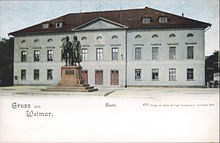Carl Friedrich Christian Steiner
Carl Friedrich Christian Steiner (* 11. September 1774 in Weimar , † 10. May 1840 ) was a German architect of classicism , the ducal as construction officer, Mr worked in Weimar.
Life
Steiner was the son of the architect Rudolf Steiner . He learned from his father at the Weimar palace building , but at the behest of Duke Karl August , went to the University of Jena in 1796 , where he supervised the ducal building projects at the same time as his studies. In 1804 Steiner stayed in Paris for further training . In 1796 he became a tutor at the Princely Free Drawing School in Weimar . From 1804 he taught geometry as a teacher at the Princely Free Drawing School in Weimar . In 1805 he became an architect.
From 1817, Carl Friedrich Christian Steiner, who had been appointed court architect a year earlier, held the title of building officer. Together with the senior building director Clemens Wenzeslaus Coudray , he designed the neo-Gothic library tower at the Duchess Anna Amalia Library . The former city tower was to be connected to the library with a connecting structure, which probably went back to a suggestion by Johann Wolfgang von Goethe in 1805. Steiner also created the temple mansion in the park on the Ilm in a neo-Gothic style. The suspension bridge from 1833 is also attributed to him. A covered wooden bridge designed by him and built between 1816 and 1818 (today with a concrete roadway) replaced an old bridge in Buchfart , which was a stone bridge until 1613 .
The court theater was designed by him after Duke Karl August had rejected plans by Goethe and Coudray. It must have been financial considerations of the duke to give preference to a functional but architecturally unappealing building. This was built in 1825 on the site of the burned down court theater and existed until its demolition in 1907 in favor of a new building, today's German National Theater . In 1816 Steiner and Coudray received the order from the Duke to design the stables. This building was not completed even under the senior building director Coudray until his death in 1845 due to lack of money, but only under his successor Carl Heinrich Ferdinand Streichhan (1814-1884).
Fonts
- The water heater. Weimar no year
- The art of tearing. Weimar 1828.
- The balance of the compound forces. Weimar 1829.
- The earth building. Weimar 1840.
literature
- Walther Scheidig : Steiner, Karl Friedrich Christian . In: Hans Vollmer (Hrsg.): General lexicon of fine artists from antiquity to the present . Founded by Ulrich Thieme and Felix Becker . tape 31 : Siemering – Stephens . EA Seemann, Leipzig 1937, p. 557 .
- Christian August Vulpius : Christian August Vulpius - a correspondence on the cultural history of Goethe's time . Ed .: Andreas Meier (= sources and research on literary and cultural history . Volume 28 ). tape 2 : comment. W. De Gruyter, Berlin 2003, ISBN 3-11-017773-0 , p. 439 .
- Kerrin Klinger: Art and craft in Weimar: from the Princely Freyen drawing school to the Bauhaus . Böhlau, Cologne / Weimar / Vienna 2009, ISBN 978-3-412-20244-6 , pp. 199 .
Web links
- Literature by and about Steiner, Carl Friedrich Christian in the bibliographic database WorldCat
- www.baufachinformation.de
- Link to Steiner's bibliographical references
- brueckenweb.de
| personal data | |
|---|---|
| SURNAME | Steiner, Carl Friedrich Christian |
| ALTERNATIVE NAMES | Steiner, Karl Friedrich Christian |
| BRIEF DESCRIPTION | German architect and construction officer |
| DATE OF BIRTH | September 11, 1774 |
| PLACE OF BIRTH | Weimar |
| DATE OF DEATH | May 10, 1840 |
| Place of death | Weimar |
